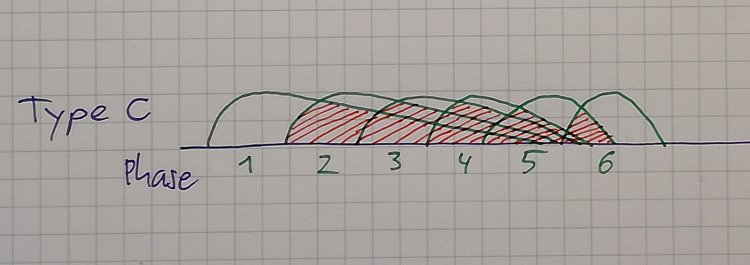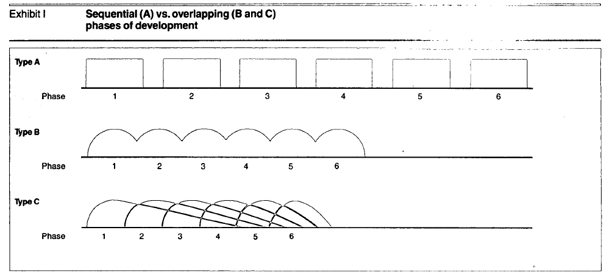30 jähriges Jubiläum von "The New New Product Development Game", Teil 5
„Overlapping development phases
The self-organizing character of the team produces a unique dynamic or rhythm. Although the team members start the project with different time horizons - with R&D people having the longest time horizon and production people the shortest - they all must work toward synchronizing their pace to meet deadlines. Also, while the project team starts from "zero information," each member soon begins to share knowledge about the marketplace and the technical community. As a result, the team begins to work as a unit. At some point, the individual and the whole become inseparable. The individual's rhythm and the group's rhythm begin to overlap, creating a whole new pulse. This pulse serves as the driving force and moves the team forward. But the quickness of the pulse varies in different phases of development. The beat seems to be most vigorous in the early phases and tapers off toward the end. (...)
Under the sequential or relay race approach, a project goes through several phases in a step-by-Step fashion, moving from one phase to the next only after all the requirements of the preceding phase are satisfied. These checkpoints control risk. But at the same time, this approach leaves little room for integration. A bottleneck in one phase can slow or even halt the entire development process. (...)
Under the holistic or rugby approach, the phases overlap considerably, which enables the group to absorb the vibration or "noise" generated throughout the development process. When a bottleneck appears, the level of noise obviously increases. But the process does not come to a sudden halt; the team manages to push itself forward. (...)
The overlapping of phases also does away with traditional notions about division of labor. Division of labor works well in a type A system, where management clearly delineates tasks, expects all project members to know their responsibilities, and evaluates each on an individual basis. Under a type B or C system, the company accomplishes the tasks through what we call "shared division of labor", where each team member feels responsible for -and is able to work on- any aspect of the project“.
Im Jahr 1986 haben Hirotaka Takeuchi und Ikujiro Nonaka ihr berühmtes Paper veröffentlicht, „The New New Product Development Game“. In ihrer Untersuchung schlugen die Autoren einen parallelen und ganzheitlichen Produktenwicklungsansatz vor, im Gegensatz zu einem seriellen, auf einzelne Phasen spezialisierten Entwicklungsansatz.
Als Takeuchi und Nonaka eine neue Herangehensweise für Produktentwicklung erläuterten, war die 3. Industrielle Revolution (der Einzug von Computertechnik) seit einigen Jahren voll im Gange.
Heute sind Digitalisierung, Industrie 4.0, Smart Factory, Internet of Things, Roboter-Mensch-Interaktion die Themen, welche in den Medien stark vertreten sind und viele Menschen beschäftigen. Dies wird in Deutschland die „4. Industrielle Revolution“ genannt und noch größere Umwälzungen als die Erschaffung des Internets werden vorausgesagt.
In dieser Reihe möchte ich Passagen des Original Papers zitieren und die Aussagen in Bezug zum Jahr 2016/2017 stellen.
***Teil 5***
Im Umgang eines Teams mit dem komplexen Kontext ist ANTESTEN-AUFNEHMEN-HANDELN die angemessene Strategie¹. Mit dieser Vorgehensweise werden ständig neue Erkenntnisse erlangt. Um diesen Wissensgewinn in die zukünftigen Handlungen des Projektteams einfließen zu lassen, muss Flexibilität ein Kernmerkmal des neuen Geschäftsmodells, des Produktes oder der Dienstleistung sein. Es kann sich z.B. herausstellen, dass die Ergebnisse des Antestens eine zuvor getroffene Annahme widerlegen und das Projektteam einige Schritte zurückgehen muss, um an einem passenden Punkt neu aufzusetzen. Dies sollte vom Projektteam nicht als Rückschlag aufgefasst werden, sondern als ein gewöhnliches Ereignis auf der Suche nach Lösungen. Damit eine solche Situation handhabbar ist und keine exorbitanten Umbauten nach sich zieht, muss das Team jedoch in seiner Arbeitsweise und im Design seiner Lösungen darauf vorbereitet sein. Der Ausruf „Change is welcome!“ drückt dies recht gut aus.

Die Art der Zusammenarbeit unter Typ C (siehe Originalabbildung und Handskizze) zeigt einen langen Zeitraum der Überlappung (rot schraffiert): Phase 1 streckt sich bis in Phase 5 hinein und ist damit offen für Änderungen, die durch neue Erkenntnisse in späteren Entwicklungsphasen gefunden wurden.
Eine gewisse „Aushärtung“ wird sich mit dem Voranschreiten der Entwicklung einstellen und ab einem bestimmten Zeitpunkt haben sich Strukturen des Entwicklungsgegenstandes gefestigt. Für neuere Bereiche oder Themen, für die es noch wenige Erkenntnisse gibt, darf dies jedoch (noch) nicht gelten. Daher ist das Team gut beraten, während der gesamten Entwicklung besonders auf die Anpassungsfähigkeit zu achten und nicht zu früh zu konsolidieren.
Referenzen
- David J. Snowden, Mary E. Boone, A Leader’s Framework for Decision Making
Harvard Business Review, 11/2007, https://hbr.org/2007/11/a-leaders-framework-for-decision-making

